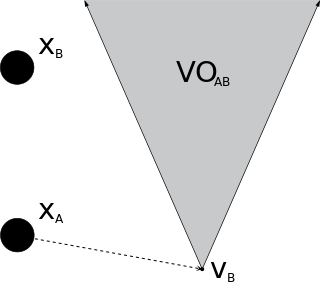
Simultaneous localization and mapping (SLAM) is the computational problem of constructing or updating a map of an unknown environment while simultaneously keeping track of an agent's location within it. While this initially appears to be a chicken or the egg problem, there are several algorithms known to solve it in, at least approximately, tractable time for certain environments. Popular approximate solution methods include the particle filter, extended Kalman filter, covariance intersection, and GraphSLAM. SLAM algorithms are based on concepts in computational geometry and computer vision, and are used in robot navigation, robotic mapping and odometry for virtual reality or augmented reality.

DART, or Demonstration for Autonomous Rendezvous Technology, was a NASA spacecraft with the goal to develop and demonstrate an automated navigation and rendezvous capability. At the time of the DART mission, only the Roscosmos and JAXA had autonomous spacecraft navigation. Orbital Sciences Corporation (OSC) was the prime contractor for construction, launch and operation of the DART spacecraft with a project cost of US$110 million (2005). The contract was awarded in June 2001 and the spacecraft was launched on 15 April 2005. The mission ended prematurely, very shortly after an anomalous slow-velocity collision with its target spacecraft, having completed less than half of the original mission autonomous rendezvous objectives.

Sebastian Thrun is a German-American entrepreneur, educator, and computer scientist. He is CEO of Kitty Hawk Corporation, and chairman and co-founder of Udacity. Before that, he was a Google VP and Fellow, a Professor of Computer Science at Stanford University, and before that at Carnegie Mellon University. At Google, he founded Google X and Google's self-driving car team. He is also an adjunct professor at Stanford University and at Georgia Tech.
Monte Carlo localization (MCL), also known as particle filter localization, is an algorithm for robots to localize using a particle filter. Given a map of the environment, the algorithm estimates the position and orientation of a robot as it moves and senses the environment. The algorithm uses a particle filter to represent the distribution of likely states, with each particle representing a possible state, i.e., a hypothesis of where the robot is. The algorithm typically starts with a uniform random distribution of particles over the configuration space, meaning the robot has no information about where it is and assumes it is equally likely to be at any point in space. Whenever the robot moves, it shifts the particles to predict its new state after the movement. Whenever the robot senses something, the particles are resampled based on recursive Bayesian estimation, i.e., how well the actual sensed data correlate with the predicted state. Ultimately, the particles should converge towards the actual position of the robot.
Motion planning, also path planning is a computational problem to find a sequence of valid configurations that moves the object from the source to destination. The term is used in computational geometry, computer animation, robotics and computer games.
Robotics is the branch of technology that deals with the design, construction, operation, structural disposition, manufacture and application of robots. Robotics is related to the sciences of electronics, engineering, mechanics, and software. The word "robot" was introduced to the public by Czech writer Karel Čapek in his play R.U.R., published in 1920. The term "robotics" was coined by Isaac Asimov in his 1941 science fiction short-story "Liar!"

Wolfram Burgard is a German roboticist. He is a full professor at the Albert-Ludwigs-Universität Freiburg where he heads the Laboratory for Autonomous Intelligent Systems. He is known for his substantial contributions to the simultaneous localization and mapping (SLAM) problem as well as diverse other contributions to robotics.

Frank Dellaert is a professor in the School of Interactive Computing at the Georgia Institute of Technology. He is also affiliated with the IRIM@GT center and is well known for contributions to Robotics and Computer Vision.

Webots is a free and open-source 3D robot simulator used in industry, education and research.
Occupancy Grid Mapping refers to a family of computer algorithms in probabilistic robotics for mobile robots which address the problem of generating maps from noisy and uncertain sensor measurement data, with the assumption that the robot pose is known. Occupancy grids were first proposed by H. Moravec and A. Elfes in 1985.
Spacecraft collision avoidance is the implementation and study of processes minimizing the chance of orbiting spacecraft inadvertently colliding with other orbiting objects. The most common subject of spacecraft collision avoidance research and development is for human-made satellites in geocentric orbits. The subject includes procedures designed to prevent the accumulation of space debris in orbit, analytical methods for predicting likely collisions, and avoidance procedures to maneuver offending spacecraft away from danger.

Dieter Fox is a German-American roboticist and a Professor in the Department of Computer Science & Engineering at the University of Washington, Seattle. He received his PhD in Computer Science at the University of Bonn in 1998. He is most notable for his contributions to several fields including robotics, artificial intelligence, machine learning, and ubiquitous computing. Together with Wolfram Burgard and Sebastian Thrun he is a co-author of the book Probabilistic Robotics.
Seth A. Hutchinson is an American electrical and computer engineer. He is the Executive Director of the Institute for Robotics and Intelligent Machines at the Georgia Institute of Technology, where he is also Professor and KUKA Chair for Robotics in the School of Interactive Computing. His research in robotics spans the areas of planning, sensing, and control. He has published widely on these topics, and is coauthor of the books "Robot Modeling and Control," published by Wiley, Principles of Robot Motion - Theory, Algorithms, and Implementations, with Howie Choset, Kevin M. Lynch, George Kantor, Wolfram Burgard, Lydia E. Kavraki and Sebastian Thrun.
In robotics, Vector Field Histogram (VFH) is a real time motion planning algorithm proposed by Johann Borenstein and Yoram Koren in 1991. The VFH utilizes a statistical representation of the robot's environment through the so-called histogram grid, and therefore places great emphasis on dealing with uncertainty from sensor and modeling errors. Unlike other obstacle avoidance algorithms, VFH takes into account the dynamics and shape of the robot, and returns steering commands specific to the platform. While considered a local path planner, i.e., not designed for global path optimality, the VFH has been shown to produce near optimal paths.
In robotics, the SEIF SLAM is the use of the sparse extended information filter (SEIF) to solve the simultaneous localization and mapping by maintaining a posterior over the robot pose and the map. Similar to GraphSLAM, the SEIF SLAM solves the SLAM problem fully, but is an online algorithm (GraphSLAM is offline).
In the class of Markov decision process algorithms, the Monte Carlo POMDP (MC-POMDP) is the particle filter version for the partially observable Markov decision process (POMDP) algorithm. In MC-POMDP, particles filters are used to update and approximate the beliefs, and the algorithm is applicable to continuous valued states, actions, and measurements.
In robotics, the exploration problem deals with the use of a robot to maximize the knowledge over a particular area. The exploration problem arises in robotic mapping and search & rescue situations, where an environment might be dangerous or inaccessible to humans.

In robotics and motion planning, a velocity obstacle, commonly abbreviated VO, is the set of all velocities of a robot that will result in a collision with another robot at some moment in time, assuming that the other robot maintains its current velocity. If the robot chooses a velocity inside the velocity obstacle then the two robots will eventually collide, if it chooses a velocity outside the velocity obstacle, such a collision is guaranteed not to occur.

Armin Bernd Cremers is a German mathematician and computer scientist. He is a professor in the computer science institute at the University of Bonn, Germany. He is most notable for his contributions to several fields of discrete mathematics including formal languages and automata theory. In more recent years he has been recognized for his work in artificial intelligence, machine learning and robotics as well as in geoinformatics and deductive databases.








